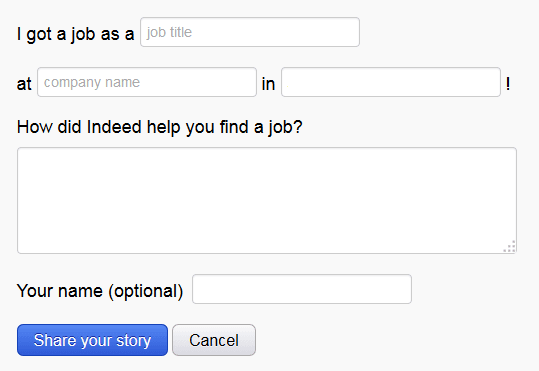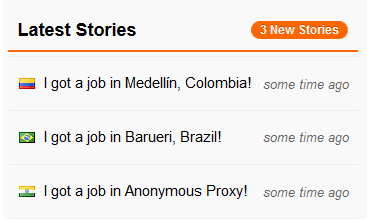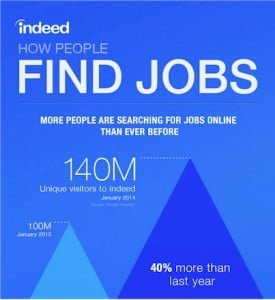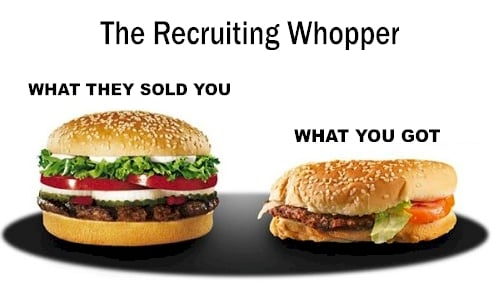In the April 2, 2019 Ask The Headhunter Newsletter a manager says he’ll never post another job on Indeed.
Question
 Indeed.com – what a joke! The first time we used Indeed was last year. We got scads of applications and scheduled four interviews. One candidate showed. The rest were all no-shows. Fortunately, we got really lucky and hired the one person who showed up. To be fair, for another job we scheduled four interviews and only one was a no-call, no-show.
Indeed.com – what a joke! The first time we used Indeed was last year. We got scads of applications and scheduled four interviews. One candidate showed. The rest were all no-shows. Fortunately, we got really lucky and hired the one person who showed up. To be fair, for another job we scheduled four interviews and only one was a no-call, no-show.
The last time we used Indeed was for an accounting position. Again, we received scads of resumes (53) and reached out to 10 people for interviews. Only four accepted. We then scheduled and confirmed them. None showed up or bothered to call to cancel.
What interested me about your article (The Bogus-ness of Indeed.com) was that we had been attributing the no-call, no-show behavior to “Millennials,” but your article has caused me to think that it may also be a by-product of using an online job board. We stopped using Craigslist for the same reason.
This is the problem with job boards. They are completely anonymous with no accountability. As a result, their “applicants” are free to be flaky without recourse. This is the last time we will use Indeed.com. Do you think anything has changed since your 2014 article?
Nick’s Reply
Maybe we can all put our heads together. I’d like to know what members of this community conclude by analyzing Indeed’s marketing and Indeed’s claims about its “success rate” in filling jobs.
What’s up at Indeed?
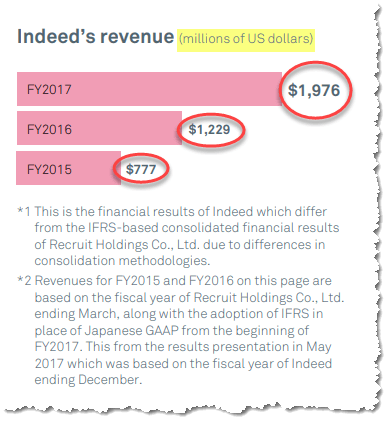
Something big changed at Indeed.com since that 2014 article. Indeed’s revenues went from $434 million (2014) to $777 million (2015) to $1.229 billion (2016).
In its 2018 annual report, Indeed’s Japanese parent, Recruit Holdings Co., LTD., reported 2017 revenues of $1.976 billion attributed to Indeed.com.
That’s a 355% increase in revenues over three years. (Gosh! Do you think somebody in HR is spending a awful lot of money on Indeed?)
What did you say was Indeed’s success rate getting Indeed’s job applicants to show up for interviews?
Since it seems you actually hired one person across three jobs you posted on Indeed in the course of a year, I suppose that’s a 33% success rate, eh?
What do other readers make of the numbers?
Marketing, Indeed
In May 2017, Indeed published this on its company blog: REPORT: Indeed Delivers 65% of Hires and 72% of Interviews from Job Sites. The article includes statements like these:
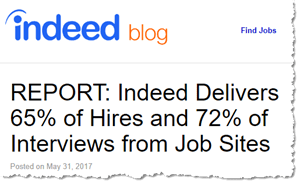
- “Indeed gets jobs for more people than all other sites combined”
- “Indeed continues to deliver more hires than any other job site”
- “According to SilkRoad, Indeed delivered 65% of all hires made in the United States from online sources in 2016, which represents a further widening of an already commanding lead”
- “Indeed delivers 2X as many hires as all other top branded external sources”
- “Indeed is responsible for 65% of all hires from job sites: effectively twice as many as all other online sources combined, and almost six times as many as second place Careerbuilder”
Who needs any other job board, website or even any employer’s own career page?
Aggregating, Indeed
Where do all those jobs that people get on Indeed really come from?
Here’s what we learn about Indeed on Wikipedia:
- “The site aggregates job listings from thousands of websites, including job boards, staffing firms, associations, and company career pages.”
- “As a single-topic search engine, it is also an example of vertical search.”
Indeed.com is a search engine that searches for just one thing, everywhere: job listings. Calling Indeed the source of 65% of all hires seems akin to calling Google the #1 source of all information because people use it to search all other websites.
The SilkRoad “Report”
The Indeed blog posting referred to above is actually about a “report” published by a company called SilkRoad: Sources of Hire 2017: Where the Candidate Journey Begins – Your Guide to Finding the Best Candidates. (That link will open the report in your browser, but you may download it from SilkRoad, which makes it freely available.)
The report claims to be a “quantitative survey” of more than “1,000 customers using SilkRoad’s applicant tracking system (SilkRoad Recruiting),” based on “15 Million Applicants, 392,00 Hires, 655,000 Interviews.” However, the survey, sampling, data gathering, and analysis methodology are not described.
The report tells us where employers found the people they hired. It breaks the “sources” of hires into two categories:
- Internal Sources of Hire: employee and personal referrals, HR, a company’s own careers web page, and internal employee movement like promotions
- External Sources of Hire: other job boards and online sources
Here’s how SilkRoad presents the numbers. Please pay attention.
- 52% of hires are made via Internal Sources
- 48% of hires are made via External Sources
- 65% of External hires are attributed to Indeed
What SilkRoad never calculates for the reader is the percentage of all hires that are attributed to Indeed. It’s a simple calculation: 65% X 48% = 31% of all hires.
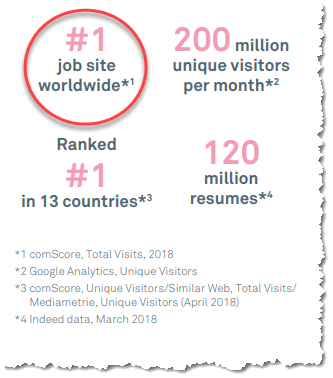
Every HR manager I know says that virtually all jobs are posted online to comply with equal opportunity hiring regulations. So I’d like to know what readers think: How can SilkRoad tease apart “Internal” and “External” Sources of hires?
What does it mean that “Indeed Delivers 65% of Hires… from Job Sites”?
According to comScore, Indeed.com was the #1 job site worldwide in 2018 based on total visits. Since Indeed “aggregates job listings from thousands of websites, including job boards, staffing firms, associations, and company career pages,” WTF are we really talking about? Is anyone impressed by that?
Take a quick look at the SilkRoad “report” and Indeed’s claims in its blog posting. What do you think it means?
Indeed at the CareerXroads
Going back to the turn of the century, my good buddies at CareerXroads — the first real job-board watchdog — conducted annual surveys of the Source of Hires at hundreds of companies. (Check this example.)
I eagerly read every one of the annual reports they issued. In over a decade, the results did not meaningfully change. Accounting for “internal” and “external” and “all” hires, every year all the major job boards in aggregate seemed to deliver only around 10% of all hires to companies surveyed.
But CareerXroads stopped conducting the survey. Here’s why: Tracking Source of Hire Is A Train Wreck. In its 2015 report, CXR said:
 The quality of the data currently found within ALL ATSs [Applicant Tracking Systems] is still, and especially today, too ugly to use for effective decision making. Vendors who bolt on other solutions to cherry pick internet candidate movement collect equally flawed data. They [mostly] embarrass themselves with their hype over their claims to be measuring ‘best source of hire data’.
The quality of the data currently found within ALL ATSs [Applicant Tracking Systems] is still, and especially today, too ugly to use for effective decision making. Vendors who bolt on other solutions to cherry pick internet candidate movement collect equally flawed data. They [mostly] embarrass themselves with their hype over their claims to be measuring ‘best source of hire data’.
If the oldest job-board watchdog gives up on trying to suss out the “Source of Hires” after over a decade of trying, what’s up with SilkRoad’s conclusion that Indeed is the source of 65% of any kinds of hires?
What do you think?
Back to our hiring manager
I’d like to thank the manager who submitted this week’s question and commentary. Yours is one of the most compelling critiques of Indeed that I’ve seen from an employer. Thanks for sharing it. Even if you filled one out of three jobs you posted in Indeed, the stunning no-show rate may be the most interesting bit of data in your story. It seems to suggest that Indeed delivers drive-by job applications. (I agree with you — I wouldn’t blame Millennials.)
Members of this community continue to recount in detail their experiences with drive-by recruiters “soliciting” them via Indeed and other job boards.
I’ve contended for years that when employers post jobs on heavily trafficked job boards, all they’re doing is turning on a fire hose. Scads of people apply just because they can click a button. Indeed and its ilk teach people that job hunting is a crap shoot, a lottery, a numbers game, a mindless enterprise. Even if you win, you know that if you show up for an interview, you’ll probably lose. So why show up? (See Reductionist Recruiting: A short history of why you can’t get hired.)
This in turn leads those very employers to criticize the quality of America’s workers — they complain there’s a “talent shortage.” But when companies go dumpster diving for job candidates, they shouldn’t be surprised at what they (don’t) find.
What’s your take?
“Indeed delivers 65% of hires.” Yup? I know job seekers are frustrated with the likes of Indeed, ZipRecruiter, LinkedIn, and Glassdoor (which is now owned by the same company that owns Indeed) — because you tell me right here on this forum.
But I’d love your take — your analysis — of the marketing information published by Indeed and SilkRoad and the other data described above. Do me a favor and run some of the numbers that are designed to make employers spend their billions of recruiting dollars on automated recruiting.
What does it all add up to? 65%? 31%? Of what? Nothing is going to change if we don’t figure it out and talk about it earnestly and loudly.
: :





 I can’t decide whether to change employers or try for an internal move. I haven’t had to search for a new job in over a decade. The number of “tools” being marketed is mind boggling! Job sites, coaches, intelligent agents (really?), video resumes, and my favorite, services that use “big data” to match me to the perfect job. I tried one service that sends jobs to my mobile, but it’s spam. Can you recommend a few of the very best services to try?
I can’t decide whether to change employers or try for an internal move. I haven’t had to search for a new job in over a decade. The number of “tools” being marketed is mind boggling! Job sites, coaches, intelligent agents (really?), video resumes, and my favorite, services that use “big data” to match me to the perfect job. I tried one service that sends jobs to my mobile, but it’s spam. Can you recommend a few of the very best services to try?
 Indeed.com – what a joke! The first time we used Indeed was last year. We got scads of applications and scheduled four interviews. One candidate showed. The rest were all no-shows. Fortunately, we got really lucky and hired the one person who showed up. To be fair, for another job we scheduled four interviews and only one was a no-call, no-show.
Indeed.com – what a joke! The first time we used Indeed was last year. We got scads of applications and scheduled four interviews. One candidate showed. The rest were all no-shows. Fortunately, we got really lucky and hired the one person who showed up. To be fair, for another job we scheduled four interviews and only one was a no-call, no-show.


 The quality of the data currently found within ALL ATSs [Applicant Tracking Systems] is still, and especially today, too ugly to use for effective decision making. Vendors who bolt on other solutions to cherry pick internet candidate movement collect equally flawed data. They [mostly] embarrass themselves with their hype over their claims to be measuring ‘best source of hire data’.
The quality of the data currently found within ALL ATSs [Applicant Tracking Systems] is still, and especially today, too ugly to use for effective decision making. Vendors who bolt on other solutions to cherry pick internet candidate movement collect equally flawed data. They [mostly] embarrass themselves with their hype over their claims to be measuring ‘best source of hire data’. I’ve read many of your posts about job boards, including
I’ve read many of your posts about job boards, including  Nick’s Quick Advice
Nick’s Quick Advice
